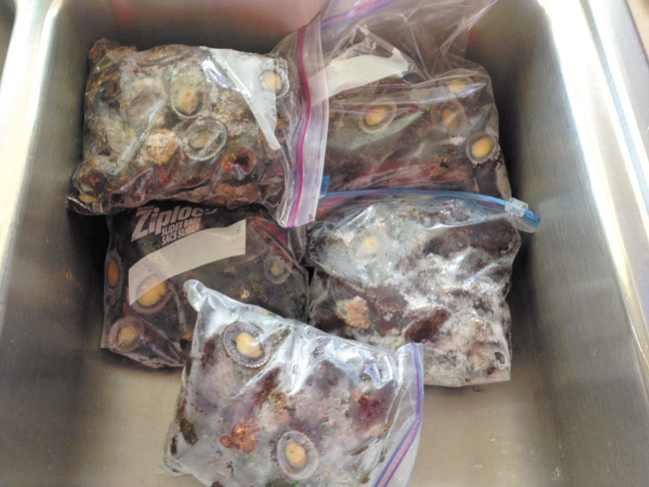Opihi: The Delicacy Of Death
It is a classic example of supply and demand — and in this case, the demand is often higher than the supply.
“You get opihi?”
It’s a question many restaurants, seafood providers and local fish markets are asked during the busy graduation season. And while most of their freezers usually are stocked with the ono ocean mollusk, poor planning is often the source of mad rushes, which lead to a spike in prices.
On most days, commercial opihi pickers charge about $200 to $250 for a gallon of opihi that is cleaned and shelled. But when demand is high, especially during graduation season, when many people are hosting parties at the same time, opihi can command up to $400 per gallon — and even more, if folks are desperate.
It’s why many people feel like they’re purchasing gold when they buy opihi, and it’s why gatherers are willing to risk their lives to pick them.
Opihi is called “the fish of death” for good reason. According to the state Department of Health, from 1993 to 1997, nine people drowned while picking opihi in Hawaii. Hawaii island saw more than a dozen opihi-related deaths from 1999 to 2009.
And the tragedies there have continued.
In June 2010, 41-year-old Joseph Pacheco Jr. was last seen leaving to pick opihi near Shipman Beach. His remains were found in the ocean several days later.
In September 2011, 20-year-old Brystan Alidon of Hilo was killed while picking opihi near Paukaa. Alidon’s friend was rescued about 50 yards offshore.
Then, in May 2012, 43-year-old Paul Kaaukai of Papaikou died while picking opihi in Onomea.
Last September, 27-year-old James McGivern Jr. of Paauilo was found floating face-down off Hamakua. Police say he was picking opihi.
And last month, 30-year-old Peter Mahoe was climbing down a cliff near Cape Kumukahi to pick opihi when he disappeared. The search for Mahoe was called off after five days.
Scientists have been asking state lawmakers for years to find solutions to help protect the precious stock of opihi, especially on Oahu, where opihi populations have dwindled from overharvesting.
Currently, opihi can be collected year-round, but shells must be at least 1 1/4 inches in the longest dimension, or the meat must be at least a half-inch in length to be harvested legally in Hawaii.
In 2012, lawmakers considered a bill relating to opihi harvesting and possession restrictions. The intent of the measure was to rehabilitate the natural populations of opihi and try to establish a new direction for management of the fishery.
The legislation called for a ban on harvesting or even possessing opihi during closed seasons, setting a bag limit for non-commercial purposes and establishing a five-year moratorium on opihi harvesting on Oahu.
According to state records, a number of groups supported the measure, including University of Hawaii, Office of Hawaiian Affairs and The Nature Conservancy. Several businesses, however, opposed the measure, including Tamashiro Market, and Boyd’s and Yama’s fish markets.
A similar bill was introduced in 2013 and included banning equipment or any apparatus that would allow a person to see and remain underwater, such a mask or snorkel. It also called for a ban on any instrument that can be used as a tool to harvest opihi, such as a knife or even live opihi.
While these measures are being amended and debated, the problem still exists and people are still dying. Perhaps it’s time we do our part before more laws are put into place.
Opihi gatherers can do a better job of being safe by using better judgment and going out with a partner, arming themselves with floatation and communication devices and always telling someone where they’re going.
And we as consumers can do a better job of planning our parties and not creating a buying frenzy with local suppliers.
The tasty opihi doesn’t have to be the delicacy of death.
rkmizutani@gmail.com






